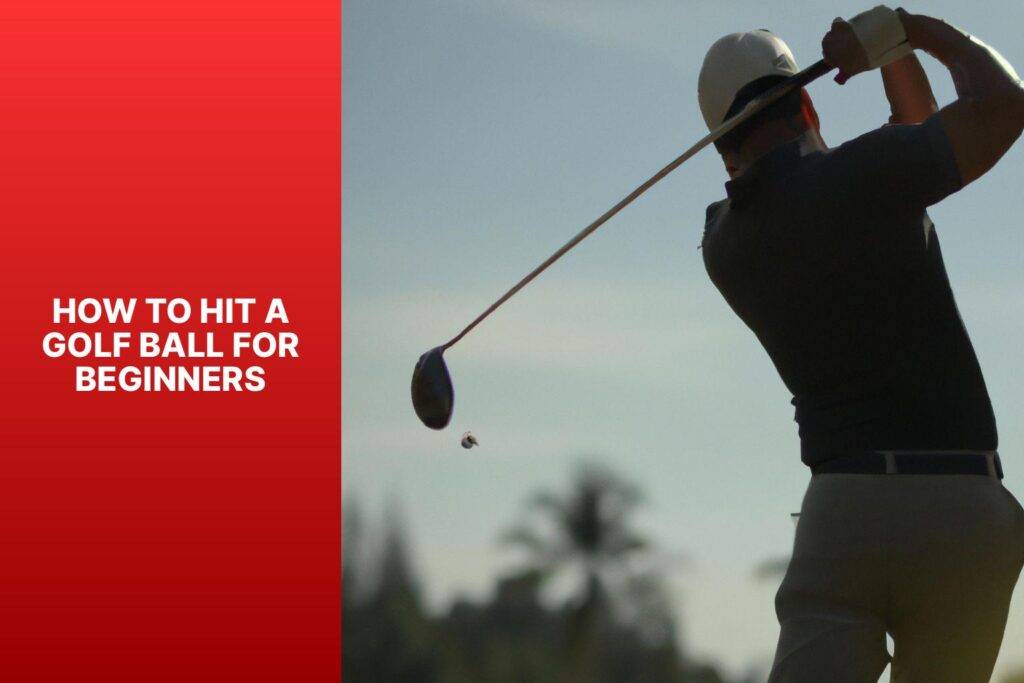I remember the first time I stepped onto the golf course as a beginner. Gripping the club with sweaty palms, I tentatively approached the ball, desperate not to embarrass myself in front of my playing partners.
As I swung and missed completely, sending turf flying through the air, I knew this sport would be more challenging than it looked on TV. But with some guidance on grip, stance and alignment, as well as plenty of practice, I slowly improved.
My shots began landing neatly on the fairway. Before long, I was hitting balls with accuracy and confidence.
Now, years later, I’m still fine-tuning my swing, but the thrill of solid contact keeps me coming back. I’m here to help other beginners start their golf journey on the right foot.
Key takeaway:
- Hitting a golf ball requires understanding the basics of the golf swing, including grip, stance, and alignment.
- Following a step-by-step guide can help beginners improve their golf swing, focusing on addressing the ball, backswing, downswing, impact, and follow-through.
- Avoid common mistakes such as gripping the club too tightly, swinging too hard, poor alignment and stance, and inconsistent tempo and rhythm.
- To improve golf swing, it is important to practice regularly, seek professional guidance, and use training aids for better results.
Understanding the Basics of Golf Swing
Mastering the art of hitting a golf ball starts with a solid understanding of the basics of the golf swing. In this section, we will dive into the key elements that can make or break your swing. From getting the right grip to setting up your stance and alignment, we’ll explore the essential foundations that will have you teeing off with confidence. So, grab your clubs and let’s uncover the secrets behind a powerful and accurate golf swing.
Grip
To have a successful golf swing, the right grip on the club is crucial. The grip is your connection to the club and determines how you control your shots. There are different grip styles, each with its own advantages and disadvantages.
Here is a table illustrating the different golf grip styles:
| Grip Style | Description | Advantages | Disadvantages |
| Neutral Grip | Palms of both hands face each other, making a “V” between thumb and index finger. | Provides balance and allows the clubface to naturally square at impact. | May require practice to feel comfortable. |
| Strong Grip | Hands are rotated clockwise on the club, with the “V” pointing towards the right shoulder (for a right-handed golfer). | Can help produce a draw or eliminate a slice. | May make it harder to control shot direction. |
| Weak Grip | Hands are rotated counterclockwise on the club, with the “V” pointing towards the left shoulder (for a right-handed golfer). | Can help produce a fade or eliminate a hook. | May make it harder to generate power. |
When gripping the club, hold it securely but not too tight. A tight grip can restrict club movement and create tension in the swing. Conversely, a loose grip can result in a loss of control and inaccurate shots.
To achieve the perfect grip, start by placing the club in the fingers of your left hand (for a right-handed golfer) with the “V” pointing towards your right shoulder. Then, wrap your fingers around the club, ensuring it is secure but not excessively tight. Next, position your right hand below your left hand, aligning the “V” of your right hand with the “V” of your left hand.
Remember to keep your wrists relaxed and maintain a firm grip throughout the swing. Practicing your grip regularly will help you develop consistency and stability in your shots.
Stance
For a golf swing to work, you need to be in the right position. To keep your base stable, make sure your feet are shoulder-width apart when you put them down. Spread your weight out evenly on both feet to get balance. A small bend in your knees will help you stay stable and move power.
Make sure your shoulders, hips, knees and feet are all square and parallel to the goal line. You will have more control over your swing if you hold the club in a strong but relaxed way.
To build a strong stance, do these things and make them a normal habit to keep getting better. You can improve your stance and swing even more by getting professional help and using training tools. You can improve your golf game and get lower scores by working on developing the right stance and skill.
Alignment
Alignment is crucial for a successful golf swing. It ensures that the body, feet, hips, and shoulders are positioned correctly in relation to the target, aiding in accurate aiming and consistent ball contact. Here are some key points for proper alignment:
1. Feet – Addressing the ball requires parallel feet placement along the target line, similar to a train track. This allows for a more accurate swing path.
2. Hip – Align the hips parallel to the target line, mirroring the placement of the feet. This ensures proper body alignment and facilitates power generation and rotation in the swing.
3. Shoulder – Align the shoulders parallel to the target line to achieve a square clubface at impact, resulting in straighter and more accurate shots.
4. Target – Before addressing the ball, choose a specific target and align yourself accordingly. This can be a spot on the fairway or a distinguishable point. Maintaining focus on the target during the swing aids in effective shot execution.
5. Body – In addition to aligning the feet, hips, shoulders, and target, ensure that the entire body is properly aligned. Maintain a neutral spine position and align the head and neck with the spine. Proper body alignment promotes a balanced and efficient swing.
Benefits of Proper Ensuring proper alignment before each swing offers several benefits:
– Accuracy: Proper alignment increases the likelihood of consistently hitting the ball towards the intended target, enhancing on-course accuracy.
– Consistency: Correct alignment leads to a more consistent swing as the body is optimally positioned to repeat the same motion with each swing.
– Power: Alignment contributes to power generation and the maximization of clubhead speed. It enables efficient energy transfer from the body to the club.
– Injury Prevention: Proper alignment helps maintain a balanced and stable swing, reducing the risk of injuries such as back strain or muscle pulls.
Step-by-Step Guide on How to Hit a Golf Ball
Want to smash golf balls better? Our step-by-step approach will have you swinging like a pro in no time. From addressing the ball to honing your backswing, downswing, impact, and follow-through, each sub-section will reveal the keys of a strong and accurate stroke. Escape those annoying slices and hooks and unleash your inner golfing superstar. Start revolutionising your game!
Addressing the Ball
Addressing the Ball is a crucial step in effective golf ball striking. To establish a solid foundation and optimal position for a successful swing, follow these steps:
- Stand in a relaxed position, feet shoulder-width apart.
- Position the ball directly in front of you, closer to the forward foot.
- Bend knees slightly to create a stable base.
- Grip the club firmly but not too tightly, with the lead hand slightly above the trail hand.
- Align your body parallel to the target line, with feet, hips, and shoulders all pointing in the same direction.
- Place the clubhead behind the ball, ensuring it is square to the target line.
- Keep your eyes focused on the ball, maintaining a neutral head position.
- Take a deep breath to calm the mind and relax the muscles.
- Visualize the desired shot, imagining the trajectory and landing spot.
- Shift your weight slightly onto the back foot, preparing for the backswing.
Maintain a relaxed and balanced posture throughout the process of addressing the ball. Grip the club firmly but not too tightly to ensure a proper swing. Properly align your body and visualize the desired shot to enhance focus and confidence in your swing.
Backswing

The backswing is crucial in setting up a successful golf shot. Here’s a step-by-step guide:
1. Addressing the Ball: Stand behind the ball, visualize your shot, position your feet shoulder-width apart, and align yourself with the target. Grip the club comfortably and neutrally.
2. Starting the Rotate: your shoulders and upper body away from the target. Keep your arms and hands relaxed while maintaining a stable lower body. The club should smoothly move away from the ball in sync with your body rotation.
3. Club Position: Continue the backswing until the club reaches a parallel position to the ground. Fully cock your wrists, with the clubhead pointing away from the target.
4. Weight Shift: Transfer your weight to the inside of your back foot while staying balanced. This shift generates power and stability during the downswing.
5. Club Position at the Top: In the top position of the backswing, the clubhead should point back down towards the target. Fully hinge your wrists, and have your lead arm parallel to the target line. Maintain a relaxed grip for a fluid and controlled downswing.
Suggestions:
- Practice your backswing regularly to improve consistency and swing mechanics.
- Experiment with different backswing lengths to find what works best for your swing and desired shot shape.
- Focus on maintaining a smooth and controlled tempo during the backswing to avoid inconsistencies.
- Seek professional guidance from a golf instructor for personalized tips and corrections.
- Use training aids like alignment sticks or swing trainers to refine your backswing mechanics and promote proper body rotation and club position.
Mastering the backswing lays the foundation for a solid and efficient golf swing. Practice regularly, seek guidance when needed, and always strive for improvement.
Downswing
When it comes to hitting a golf ball, the downswing greatly impacts your shot. Here are the steps to execute a proper downswing:
1. Shift your weight: Transition from the backswing to the downswing by shifting your weight from your back foot to your front foot. This generates power and control.
2. Lead with your hips: Initiate the downswing by rotating your hips towards the target. This creates a powerful and consistent swing.
3. Keep your arms connected: Ensure that your arms stay connected to your body throughout the downswing. This promotes a compact and efficient swing.
4. Let the club drop naturally: Allow the club to drop naturally from the top of the backswing to the start of the downswing. Avoid any forced or abrupt movements.
5. Start the club down: Begin the downward movement of the club using your lower body and core. This leads to a smooth and controlled swing.
6. Keep your wrists lagged: Maintain a slight lag in your wrists as you approach impact. This helps generate clubhead speed and power.
7. Rotate your forearms: Just before impact, rotate your forearms to square the clubface. This ensures a straighter shot and better control.
8. Follow through: After making contact with the ball, continue your swing towards the target. Maintain good balance and complete the full swing motion.
To enhance your downswing and improve your golf swing overall, consider the following suggestions:
1. Practice regularly: Consistent practice is key to refining your downswing and improving your golf game. Set aside dedicated time for practice sessions.
2. Get professional guidance: Seek guidance from a golf instructor who can provide personalized tips and feedback on your downswing technique. Their expertise is invaluable.
3. Use training aids: Incorporate training aids such as alignment sticks or swing trainers to develop a better downswing. These tools provide additional support and feedback.
Impact

The impact of the golf swing is crucial as it determines both the trajectory and distance of the ball. Proper technique and timing play an essential role in achieving a successful impact. To optimize your impact, consider the following key factors:
1. Swing speed: The speed at which you swing the club greatly influences the distance the ball will travel. By increasing your swing speed, you can achieve a more powerful impact and longer shots.
2. Centered contact: Striking the ball with the center of the clubface ensures the maximum transfer of energy. Aim for the sweet spot of the club to achieve optimal results.
3. Angle of attack: The angle at which the clubhead approaches the ball affects its launch angle and spin. A shallow angle promotes a higher launch, while a steep angle produces a lower trajectory.
4. Hand position: The position of your hands at impact greatly influences the direction and flight of the ball. Skilled golfers position their hands ahead of the ball for a proper downward strike.
5. Ball position: The placement of the ball in your stance affects the angle of attack and the contact point on the clubface. Positioning the ball forward promotes a shallower angle, while positioning it back creates a steeper angle.
6. Body position: Maintaining proper alignment and shifting your weight to the front foot at impact generate more power and ensure a consistent strike.
Remember, practice is essential for perfecting your impact. Experiment with different techniques and seek professional guidance to refine your swing. By focusing on these elements, you can enhance the impact and improve your golf game.
RELATED:How To Pitch a Golf Ball Onto The Green
Follow-through
Follow-through is a crucial part of a successful golf swing. It refers to the motion and position of the golfer after striking the golf ball. Proper follow-through ensures maximum power and control in the swing. Here is a step-by-step guide on executing a correct follow-through:
1. Keep your eyes on the ball: Stay focused on the ball for a clean strike.
2. Rotate your hips: Let your hips naturally rotate towards the target after impact for power and accuracy.
3. Extend your arms: Fully extend your arms while rotating your hips to maximize clubhead speed.
4. Release the club: Let the club naturally follow-through as you extend your arms, without manipulating it forcefully.
5. Shift your weight: Transfer your weight from your back foot to your front foot to maintain balance and control.
A proper follow-through shows a well-executed swing and improves accuracy, distance, and consistency in your golf game. It allows your body to complete the full swing motion naturally, promoting fluidity and power. By following these steps, you can master the art of the follow-through and enhance your performance on the golf course.
Common Mistakes to Avoid

Beginners make typical golf ball-hitting blunders that might slow them down. This section will reveal these dangers and offer solutions.
We’ll cover each sub-section in detail to help you improve your golfing skills and game, from holding the club too tightly to swinging too forcefully, poor alignment and stance, and inconsistent tempo and rhythm. Let’s face these mistakes head-on!
Gripping the Club Too Tightly
Try not to grasp the golf club too tightly. A tight grip decreases swing performance. Take into account:
1. Hand tension: Tight grips cause hand and forearm tension. This hinders club movement and swing. For a fluid swing, loosen your grip.
2. Slower clubhead: Tight grips slow clubheads. Tension in wrists and muscles slows club release, making shots weaker and shorter.
3. Lack of control: Tight clubhandling reduces clubface control. It becomes hard to square the clubface upon impact, resulting in uneven shots and lower accuracy. Relaxing your grip improves clubface control and consistency.
4. weariness and discomfort: Long-term gripping produces hand and forearm weariness. This hinders grip consistency throughout the round. Relaxing your grip reduces fatigue and improves performance.
5. Adjusting grip pressure: Grip lightly but securely to avoid overgripping. Imagine holding a bird—firm enough to keep it from flying but light enough to avoid harm. Check your grip pressure during swings to keep it relaxed.
Avoid overgripping the club to improve your golf swing and performance. Practice a relaxed grip and focus on other swing elements for better results.
RELATED: How to Spin a Golf Ball?
Swinging Too Hard
Swinging too hard in golf can have a detrimental impact on your swing technique and overall performance. It is crucial to consider the following important facts:
1. Strain on the body: Swinging excessively hard can strain your muscles and joints, which increases the risk of injuries. It is important to maintain proper form and avoid applying excessive force.
2. Loss of control: Swinging too forcefully often results in a loss of control over the golf ball. It is advisable to prioritize accuracy and control instead of focusing solely on power.
3. Inconsistent swing plane: A swing that is too forceful can lead to an erratic swing plane, resulting in inaccurate shots. To achieve better outcomes, it is important to have a smooth and consistent swing.
4. Decreased clubhead speed: Contrary to expectations, swinging too hard can actually decrease clubhead speed. In order to maximize speed and distance, it is recommended to have a relaxed and fluid swing.
5. Impact on timing and rhythm: Excessive force during a swing can disrupt your natural timing and rhythm. It is essential to develop a balanced swing with proper sequencing and tempo.
6. Diminished accuracy: Swinging too hard often leads to reduced accuracy. It is crucial to focus on consistency and precision in your swing.
To avoid these negative consequences, it is important to maintain a balanced and controlled swing. Regular practice, focusing on technique and tempo, is key. Seeking professional guidance can also be beneficial in refining your swing. Always remember, swinging too hard rarely improves performance on the golf course.
Poor Alignment and Stance
Poor alignment and stance can greatly affect your golf swing. Proper alignment and stance are crucial for accuracy and consistency with your shots. Consider the following points:
- Alignment: Align your body parallel to the target line by positioning your feet, hips, shoulders, and clubface towards the target. Misalignment can cause the ball to go off target. If you have poor alignment and stance, it can lead to inconsistent shots.
- Stance: Maintain balance, stability, and power in your swing with a correct stance. Your feet should be shoulder-width apart, with the ball in line with the front foot. Distribute your weight evenly and slightly flex your knees. Poor alignment and stance can lead to inconsistency and loss of power in your shots.
- Visual Alignment Aids: Use visual alignment aids like intermediate targets, alignment sticks, or golf training aids. These aids provide visual references to ensure proper alignment. Visual alignment aids can be particularly helpful in improving poor alignment and stance.
- Practice: Regularly practice aligning your body and club correctly before each shot. This will develop muscle memory and make proper alignment and stance second nature. By addressing poor alignment and stance through practice, you can improve your overall golf game.
- Get Feedback: Seek guidance from a golf instructor or experienced player to identify alignment or stance issues. They can offer corrections and guidance to improve your alignment and stance. Getting feedback is important in addressing poor alignment and stance and making necessary adjustments.
I had trouble with bad alignment and stance, which made my shots less reliable. I learned how important it is to align my body and club properly after getting help from a golf instructor. My alignment and stance got better with regular practice, visual alignment tools, and changes based on feedback.
Through this, I was able to improve the precision and consistency of my golf swing. Don’t forget how important it is to have the right balance and stance for your game. Spend some time on these things, and you’ll see your golf game get better.
Inconsistent Tempo and Rhythm
Inconsistent tempo and rhythm in golf swings can have a significant impact on both accuracy and power. To address these issues and improve your swing, here are some important points to consider:
- Discover Your Natural Tempo: It’s crucial to identify and establish your own comfortable tempo through regular practice. This will allow you to develop a consistent and repeatable swing.
- Maintain a Balanced Stance: Ensuring that your feet are shoulder-width apart and distributing your weight evenly between them is key. This will help you maintain stability and control, leading to a smoother tempo.
- Utilize a Metronome for Practice: Incorporating a metronome into your practice sessions can be extremely beneficial. Set the metronome to a comfortable speed and practice swinging in sync with the beats. This will train your body to maintain a consistent tempo.
- Focus on the Transition: Avoid sudden or jerky movements when transitioning from the backswing to the downswing. Engaging in drills that emphasize this transition will help you achieve a fluid and consistent swing.
- Relax and Breathe: Staying relaxed throughout your swing and maintaining consistent breathing is essential. This will contribute to a smooth and fluid motion, ultimately enhancing your tempo and rhythm.
By addressing and improving your inconsistent tempo and rhythm, you can expect to see a boost in the accuracy, power, and overall consistency of your golf swing. Make it a priority to practice regularly, maintain a balanced stance, and incorporate tools like a metronome to achieve a smooth and consistent tempo.
Tips for Improving Golf Swing

Looking to improve your golf swing? In this section, we’ve got you covered with some game-changing tips. From regular practice to seeking professional guidance and utilizing training aids, we’ll explore the key elements that can skyrocket your golf game. So, grab your clubs and get ready to unleash your inner Tiger Woods. It’s time to elevate your swing to a whole new level. Let’s dive in!
RELATED: What’s the Value of Used Golf Balls?
Practice Regularly
Practicing regularly is key to improving your golf swing. If you want to practice regularly, here’s a helpful guide to follow:
- Create a schedule: Make sure to allocate dedicated time each week specifically for practice. Aim for three to four sessions per week at the minimum.
- Warm-up: Prior to each practice session, it’s important to warm up your body by engaging in stretching exercises and light workouts. This will prepare your body for the golf swings.
- Focus on fundamentals: During your practice sessions, pay close attention to important fundamentals such as grip, stance, and alignment. It’s crucial to focus on your technique and form.
- Vary your sessions: To keep your practice sessions interesting and challenging, be sure to mix up your routines. Practice different types of shots including drives, iron shots, and putting.
- Practice with goals: Set specific goals for each practice session. Concentrate on improving a particular aspect of your swing to help you progress.
- Take breaks: It’s essential to give yourself sufficient breaks between practice sessions to avoid overexertion and burnout. This will allow your body to recover and rejuvenate.
- Seek feedback: To identify areas for improvement, have someone knowledgeable observe your practice sessions and provide feedback. This feedback will be valuable in refining your skills.
Fact: Regular practice builds muscle memory and consistency in your golf swing. It internalizes proper techniques, making them more natural. By practicing regularly, you can enhance your skills and performance on the golf course.
Get Professional Guidance
When it comes to improving your golf swing, seeking professional guidance can be highly beneficial. Professional golf instructors have the expertise and knowledge to help refine your technique and take your game to the next level. Consider the following steps when seeking professional guidance:
- Research reputable golf instructors in your area, specifically those with experience working with golfers of all skill levels.
- Contact the instructors you are interested in and inquire about their availability, as many offer individual and group lessons.
- Schedule an initial consultation or lesson with your chosen instructor. During this session, discuss your goals and areas of your golf swing that you would like to improve.
- Pay close attention and observe the instructor’s guidance and demonstration of proper technique. Take note of any mistakes or areas that could be adjusted.
- Practice regularly to reinforce what you have learned. Follow the instructor’s advice and drills to improve your swing.
- Seek feedback and ongoing guidance by scheduling follow-up lessons with the instructor. This will help track your progress and receive further instruction.
- Record your swing using video recording during practice sessions and share these videos with your instructor for analysis and feedback.
- Take advantage of golf clinics or workshops offered by the instructor. These group sessions provide additional opportunities to refine your technique and learn from others.
By seeking professional guidance, you can receive personalized instruction, identify areas for improvement, and work on refining your golf swing. With practice and the right guidance, you can enhance your skills and enjoy a more effective and consistent golf game.
Use Training Aids
Training aids are valuable tools for improving your golf swing. They help enhance various aspects of your technique and improve overall performance. Here are some aids that can take your golf game to the next level:
- Alignment sticks: These rods improve alignment. Place them on the ground to align your feet, hips, and shoulders with your target. Consistently using alignment sticks during practice sessions can develop a more consistent and accurate swing.
- Swing trainers: These aids come in various forms, including weighted clubs, golf training balls, and swing tempo trainers. They help develop the correct swing path, timing, and tempo. They also provide resistance or feedback to build muscle memory for a controlled and powerful swing.
- Golf impact bags: These durable bags simulate the impact zone. Hitting them with your golf club improves ball striking and increases power. Practicing with an impact bag helps deliver the clubhead properly at impact, resulting in more solid and accurate shots.
- Putting mats: Using a putting mat helps improve accuracy and distance control. These mats have alignment guides and target holes to practice stroke and develop a consistent putting routine.
- Golf swing analyzers: These high-tech devices track and analyze various aspects of your swing, such as club speed, tempo, and swing path. They provide real-time feedback to identify areas that need improvement. Utilizing a swing analyzer allows data-driven adjustments to maximize potential on the course.
Using training aids can greatly accelerate progress in golf by providing specific feedback and targeting areas of improvement. It is important to note that training aids are tools and should not replace proper instruction and practice. It is always recommended to work with a golf professional or coach who can guide you in using training aids effectively and ensure the correct fundamentals are developed. With consistency, dedication, and the right training aids, you can enhance your golf swing and take your game to new heights.
Frequently Asked Questions
How should beginners position themselves to hit a golf ball effectively?
Beginners should start by setting a wide stance, with their feet slightly wider than their shoulders. The ball should be positioned in front of their dominant foot to allow the driver to square up with it. They should grip the club like a baseball bat, with the dominant hand in front and hold the driver about 10-12 inches away from their body. To tee the ball up high, they should use a tee that is 2.75 inches in height.
What are the key steps in swinging a golf club for beginners?
Beginners should begin by picking a target in the distance to aim for, instead of just looking down the green. They should loosen up by wagging the club back and forth before starting their backswing. Throughout the swing, they should strive to keep their balance and center of gravity in the middle. During the downswing, they should use a sweeping motion and shift their balance forward. After hitting the ball, they should swing through it and maintain arm speed.
What is the importance of proper posture in hitting a golf ball?
Proper posture is essential in hitting a golf ball effectively. It involves bending at the hips, ensuring the arms are below the shoulders, and aligning the chest over the toes. This posture provides stability and allows for a more controlled and powerful swing.
How often should beginners practice hitting golf balls?
Beginners should aim to practice hitting golf balls regularly at the driving range. It is recommended to hit at least 50 balls per session and take two practice swings for each ball. Regular practice helps newcomers to improve their skills, develop good rhythm, and enhance both accuracy and distance.
What are some recommended golf balls for beginners?
For beginners, golf balls that enhance hitting distance and have a soft feel are often recommended. Popular choices include the Titleist Trufeel and Callaway ERC Soft. It is important for beginners to experiment with different balls to find the best fit in terms of feel and swing speed.
How can beginners improve their swing speed in golf?
To improve swing speed, beginners can focus on several key things. These include proper posture, hip rotation, arm placement, and maintaining a sweeping motion during the swing. Working with a PGA professional or utilizing tools such as the Boditrak pressure mapping and Blast Motion can provide valuable insights and help beginners increase their swing speed.

I’m Donna Weiss, and I am the proud writer behind the captivating content you’ll find on golfneedy.com. As an avid golfer and passionate writer, I have combined my two greatest passions to bring you an incredible golfing experience. Through my articles, I aim to provide you with valuable insights, equipment reviews, and updates on the latest tournaments. Whether you’re a seasoned golfer or just starting out on this exciting journey, I am here to guide you and share my expertise. Together, let’s explore the fascinating world of golf, uncovering new techniques, and enhancing our skills. Join me on this thrilling adventure as we elevate our game and embark on an exciting golfing journey. Read More



